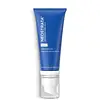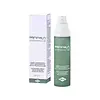What's inside
What's inside
 Key Ingredients
Key Ingredients

 Benefits
Benefits

 Concerns
Concerns

 Ingredients Side-by-side
Ingredients Side-by-side

Water
Skin ConditioningGlyceryl Stearate
EmollientGlycolic Acid
BufferingMaltobionic Acid
BufferingGluconolactone
Skin ConditioningButyrospermum Parkii Butter
Skin ConditioningIsononyl Isononanoate
EmollientGlycerin
HumectantButylene Glycol
HumectantStearyl Alcohol
EmollientHydrogenated Polydecene
EmollientArginine
MaskingCyclopentasiloxane
EmollientPEG-100 Stearate
Dimethicone
EmollientAmmonium Hydroxide
BufferingPropylene Glycol
HumectantCetyl Alcohol
EmollientCyclohexasiloxane
EmollientPalmitoyl Tripeptide-1
Skin ConditioningPalmitoyl Tetrapeptide-7
Skin ConditioningTocopheryl Acetate
AntioxidantMalus Domestica Fruit Cell Culture Extract
Skin ConditioningVitis Vinifera Seed Extract
AntimicrobialEuterpe Oleracea Fruit Extract
Punica Granatum Extract
AstringentVaccinium Angustifolium Fruit Juice
AstringentRosa Damascena Flower Oil
MaskingMethyldihydrojasmonate
MaskingEthylene Brassylate
MaskingCaprylyl Glycol
EmollientLecithin
EmollientPEG-75 Stearate
Steareth-20
CleansingCeteth-20
CleansingTriethyl Citrate
MaskingXanthan Gum
EmulsifyingMagnesium Aluminum Silicate
AbsorbentPentaerythrityl Tetra-Di-T-Butyl Hydroxyhydrocinnamate
AntioxidantSodium Bisulfite
AntioxidantDisodium EDTA
Carbomer
Emulsion StabilisingPolysorbate 20
EmulsifyingChlorphenesin
AntimicrobialPhenoxyethanol
PreservativeCaramel
Cosmetic ColorantCI 19140
Cosmetic ColorantWater, Glyceryl Stearate, Glycolic Acid, Maltobionic Acid, Gluconolactone, Butyrospermum Parkii Butter, Isononyl Isononanoate, Glycerin, Butylene Glycol, Stearyl Alcohol, Hydrogenated Polydecene, Arginine, Cyclopentasiloxane, PEG-100 Stearate, Dimethicone, Ammonium Hydroxide, Propylene Glycol, Cetyl Alcohol, Cyclohexasiloxane, Palmitoyl Tripeptide-1, Palmitoyl Tetrapeptide-7, Tocopheryl Acetate, Malus Domestica Fruit Cell Culture Extract, Vitis Vinifera Seed Extract, Euterpe Oleracea Fruit Extract, Punica Granatum Extract, Vaccinium Angustifolium Fruit Juice, Rosa Damascena Flower Oil, Methyldihydrojasmonate, Ethylene Brassylate, Caprylyl Glycol, Lecithin, PEG-75 Stearate, Steareth-20, Ceteth-20, Triethyl Citrate, Xanthan Gum, Magnesium Aluminum Silicate, Pentaerythrityl Tetra-Di-T-Butyl Hydroxyhydrocinnamate, Sodium Bisulfite, Disodium EDTA, Carbomer, Polysorbate 20, Chlorphenesin, Phenoxyethanol, Caramel, CI 19140
Water
Skin ConditioningIsononyl Isononanoate
EmollientCoco-Caprylate/Caprate
EmollientC14-22 Alcohols
Emulsion StabilisingXylitylglucoside
HumectantHydroxyethyl Acrylate/Sodium Acryloyldimethyl Taurate Copolymer
Emulsion StabilisingPolymethyl Methacrylate
Sodium Hyaluronate
HumectantSalvia Haenkei Extract
EmollientDisodium EDTA
Anhydroxylitol
HumectantXylitol
HumectantC12-20 Alkyl Glucoside
EmulsifyingSqualane
EmollientPolysorbate 60
EmulsifyingArginine
MaskingPhenoxyethanol
PreservativeBenzoic Acid
MaskingDehydroacetic Acid
PreservativeEthylhexylglycerin
Skin ConditioningWater, Isononyl Isononanoate, Coco-Caprylate/Caprate, C14-22 Alcohols, Xylitylglucoside, Hydroxyethyl Acrylate/Sodium Acryloyldimethyl Taurate Copolymer, Polymethyl Methacrylate, Sodium Hyaluronate, Salvia Haenkei Extract, Disodium EDTA, Anhydroxylitol, Xylitol, C12-20 Alkyl Glucoside, Squalane, Polysorbate 60, Arginine, Phenoxyethanol, Benzoic Acid, Dehydroacetic Acid, Ethylhexylglycerin
Ingredients Explained
These ingredients are found in both products.
Ingredients higher up in an ingredient list are typically present in a larger amount.
Arginine is an amino acid that is important for human development. Your body uses is it to produce hair keratin and skin collagen.
As a cosmetic ingredient, Arginine has antioxidant properties and can also help repair damaged skin. This ingredient is derived either synthetically or from animals.
Arginine isn't fungal acne safe when used in the presence of other lipids (fats, fatty acids, oils, esters, etc). Oils and fats occur naturally within the skin, so take caution when using Arginine if you're prone to fungal acne.
Learn more about ArginineDisodium EDTA plays a role in making products more stable by aiding other preservatives.
It is a chelating agent, meaning it neutralizes metal ions that may be found in a product.
Disodium EDTA is a salt of edetic acid and is found to be safe in cosmetic ingredients.
Learn more about Disodium EDTAIsononyl Isononanoate is a synthetic skin-conditioner and texture enhancer. It is created from nonanoic acid, a fatty acid found in cocoa and lavender oil.
As an emollient, Isononyl Isononanoate helps keep your skin soft and smooth. This is because emollients create a barrier on the skin to trap moisture in.
Isononyl Isononanoate helps give products a velvet feel and improves spreadability.
Learn more about Isononyl IsononanoatePhenoxyethanol is a preservative that has germicide, antimicrobial, and aromatic properties. Studies show that phenoxyethanol can prevent microbial growth. By itself, it has a scent that is similar to that of a rose.
It's often used in formulations along with Caprylyl Glycol to preserve the shelf life of products.
Water. It's the most common cosmetic ingredient of all. You'll usually see it at the top of ingredient lists, meaning that it makes up the largest part of the product.
So why is it so popular? Water most often acts as a solvent - this means that it helps dissolve other ingredients into the formulation.
You'll also recognize water as that liquid we all need to stay alive. If you see this, drink a glass of water. Stay hydrated!
Learn more about Water